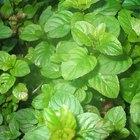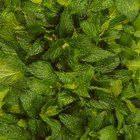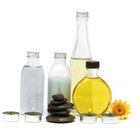
Patchouli essential oil is made from a plant, originally from India, where it is known as puchaput. It was popularized in Europe during the 1800s and again rose to infamy in the Unites States during the 1960's when "flower children" and "hippies" wore the scent religiously. It has a strong aroma and gets even stronger in scent over time. So if you are interested in utilizing patchouli for its aromatherapy properties (which are many--anti-depressant, antiviral, digestive, diuretic, as well as fungicidal--to name a few), then applying the full-strength oil, in small doses, might be recommended. For all other applications of the oil, you should dilute it.
Choose an organic carrier oil. Jojoba oil has the greatest trans-dermal properties of all the carrier oils, which means that the benefits reported to be present with any essential oil, when added to the carrier, will find the greatest absorption rate into your skin.
Mix 25 drops of the patchouli oil with 2 oz. of jojoba oil. This is a great massage blend; a subtle aromatherapy treatment that can be applied to your pulse points directly on the skin--under your neck glands and inside wrists. The aroma can also be dispersed into the atmosphere of your home through an air diffuser.

Put eight drops of patchouli essential oil in one tub of bathwater as another way to enjoy a softer application of this oil. This makes for a safe, pleasant and therapeutic soak.
Related Articles

Sandalwood Soap Benefits

Is Peppermint Oil Good for Skin Care?

Eucalyptus Oil & Acne

Peppermint Oil for a Cough

Can Borage Oil Help Acne?

The Use of Neem Juice in Skin Care as ...

How to Mix & Safely Use Patchouli ...

Anise Seed Cautions and Side Effects

How to Make Roll-On Perfume

Jojoba Oil Benefits

Lavender Oil & Acne

Carrot Oil for Acne

How to Dilute Peppermint Oil for Hair ...

How to Make Essential Oil From Flower ...

Herbs For Saunas

How to Make Body Oil With Glycerin

How to Make Slippery Body Oil

Sandalwood Soap Benefits

How to Make Cologne From Essential Oils

Benefits of Orange Flower Water